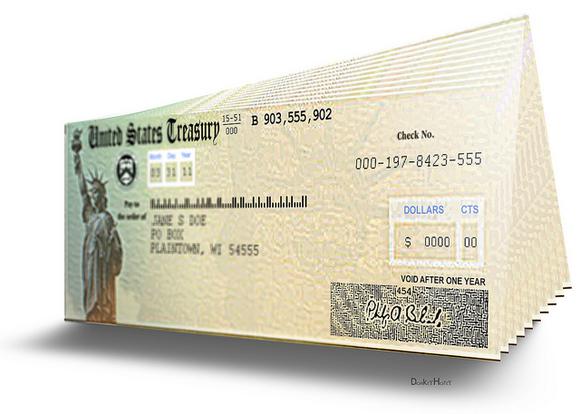Despite what you may have heard, most Americans do the right thing with their tax refund.
By Matthew Frankel
According to the IRS, about 80% of all 2015 tax returns have resulted in a refund, and the average refund amount is $3,120. Since the IRS expects about 150 million tax returns in total, this implies that nearly $375 billion will be returned to taxpayers for the 2015 tax year. And, despite popular misconceptions, it looks like most people use their tax refund responsibly. Here’s how Americans are planning to use the tax refunds they receive in 2016, and a few tips to get the most out of yours.
How Americans use their tax refunds
According to Bankrate’s Money Pulse survey, the overwhelming majority of Americans plan to do something responsible with their tax refunds — including saving, investing, paying off debt, or helping out with necessities.
On the other hand, just a small percentage plan to splurge with their refunds on things like vacations and shopping sprees. It’s worth noting that the 6% who said this is twice as many as last year — perhaps due to continued improvement in the economy.
| Use of Tax Refund | Percentage of Respondents |
|---|---|
| Save or invest | 31% |
| Pay down debt | 28% |
| Essentials (food, utilities, etc.) | 27% |
| Splurge (vacation, shopping spree) | 6% |
| None of the above/Don’t know | 8% |
Data source: Bankrate.
So, statistically speaking, most of the people reading this article are planning on doing one of the first three things on the list. If you need the money to help cover essentials, that should absolutely be your first priority. In fact, if you’re having a tough time paying for the basics and you’re getting a big refund, it might be a smarter idea to adjust your withholding so instead of getting a lump sum next year, you’ll just get more money with each paycheck.
If you plan to pay down debt or save/invest the money, here are some quick suggestions to maximize your refund’s effect on your financial well-being.
Pay down debt effectively
When paying down your debts, it’s important to work in order from the highest interest rates to the lowest interest rates. It makes my blood boil when I hear about someone making an extra car payment, all while carrying credit card debt at 20% interest.
If you have any high-interest credit card debt, it’s important to take care of that first. Just think of it this way — if you have $5,000 in credit card debt at 20% interest, you’re literally paying $1,000 annually for the privilege of owing money. It doesn’t even make sense to invest while you have credit card debt — good investors earn returns averaging about 10% per year, and you’ll pay much more than that in interest.
After your high-interest debts have been taken care of, then it could make sense to pay down other forms of debt, such as student loans or your car loan.
Notice I didn’t say “mortgage.” With today’s cheap mortgage rates, I happen to believe that most people are better off saving and investing, rather than aggressively paying down their mortgage. Now, I completely understand that some people have a desire to become completely debt-free, and there’s nothing wrong with that, but I feel it’s somewhat counterproductive to use investable money on low-interest debt.
If you plan to save or invest your refund
Saving or investing your refund is a great idea, but saving it the right way is even better. And, the right way to save for you depends on your situation.
First of all, if you don’t have any money set aside for unforeseen expenses, start here. Experts say that you should have at least six months’ worth of expenses set aside, and that’s admittedly a pretty big amount of money. However, something in the bank is better than nothing.
Bankrate also found that nearly three out of every 10 people has no emergency savings at all, and a separate Federal Reserve report found that 47% of Americans couldn’t cover an unexpected $400 emergency expense without borrowing the money or selling something. So, if you don’t have at least a little bit of a cushion in the bank, setting up an emergency fund is probably the best use of your refund. After all, who wants to go into debt every time their car needs a tire or they need to take their dog to the vet?
If your essentials are paid for and you’ve got a bit of emergency savings, the next thing I would suggest is saving for your retirement in an IRA. If you don’t have one already, an IRA allows you to set aside money and invest for your retirement with some pretty nice tax advantages. IRAs come in two main varieties, traditional and Roth, and contributions to a traditional IRA could get you a tax deduction on your 2016 taxes.
On the other hand, Roth IRA contributions aren’t deductible, but your eventual withdrawals in retirement will be tax-free. Plus, Roth contributions can be withdrawn at any time for any reason, effectively making a Roth IRA a retirement account and emergency fund in one.
With either account type, low- to moderate-income taxpayers could get an additional tax credit — the Retirement Savings Contributions Credit — on top of the other tax benefits that come with the account.
For 2016, you can put up to $5,500 into an IRA, so that’s a good place to park some or all of your tax refund. Once you contribute, you can invest in pretty much any stocks, bonds, or funds you want. Of course, if you’ve already maxed out your IRA contributions for the year (good for you!), you can invest your refund in a regular brokerage account or start a 529 plan or Coverdell ESA to help pay for your kids’ education.
Don’t be one of the 6%
If you get a big tax refund this year, there’s absolutely nothing wrong with treating yourself a little. Take the family out to a nice dinner, or buy those new shoes you’ve been wanting.
However, the last thing you want to do with your tax refund is to run out and spend it like it was “extra money” by splurging on a fancy vacation or any other big-ticket purchase you wouldn’t have made otherwise. Your tax refund is part of your salary, just deferred, and it should be treated as such. Would you take your entire paycheck and blow it at the mall? Of course not — you’d make sure your bills and savings needs were taken care of, and then use a little for whatever you want. The same logic applies here.
A secret billion-dollar stock opportunity
The world’s biggest tech company forgot to show you something, but a few Wall Street analysts and the Fool didn’t miss a beat: There’s a small company that’s powering their brand-new gadgets and the coming revolution in technology. And we think its stock price has nearly unlimited room to run for early-in-the-know investors! To be one of them, just click here.
Try any of our Foolish newsletter services free for 30 days. We Fools may not all hold the same opinions, but we all believe that considering a diverse range of insights makes us better investors. The Motley Fool has a disclosure policy.
















